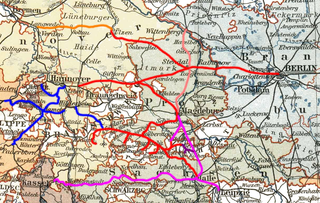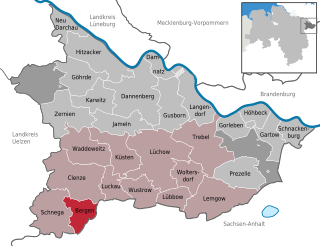
The Hanover–Berlin high-speed railway is a 258 kilometre railway line linking the German cities of Hanover and Berlin
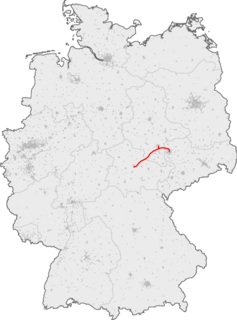
The Erfurt–Leipzig/ Halle high-speed railway is a 123 km-long German high-speed line between Erfurt and Leipzig and Halle.
The Bremen State Railway was a railway line built by the Free Hanseatic City of Bremen on Prussian state territory. In spite of its name and although owned by the state it was operated under Prussian law as a private railway. Constructionally it formed the 97 km long Uelzen–Langwedel railway, the western section of the America Line.
The Brunswick–Uelzen railway line is a largely, single-tracked, non-electrified branch line in the north German state of Lower Saxony. It serves the northern part of Brunswick Land and the eastern region of the Lüneburg Heath. The most important station en route is Gifhorn. The line has also been called the Mühlenbahn for several years due to the many mills along its route.
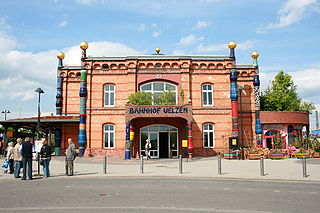
Uelzen is a railway station located in Uelzen, Germany, at the eastern edge of the Lüneburg Heath Nature Park. The station is located on the Hannover–Hamburg railway, Uelzen–Langwedel railway, Stendal–Uelzen railway and Brunswick–Uelzen railway. The train services are operated by Deutsche Bahn, Metronom and Erixx.

Soltau (Han) station is in the town of Soltau in the German state of Lower Saxony, located in the centre of the Lüneburg Heath. As a junction station on two railway lines, Hannover Hbf – Buchholz (Heath Railway) and Bremen Hbf – Uelzen (Uelzen–Langwedel railway), it is a central transport hub of the region and serves commuters and visitors to the Lüneburg Heath as a destination and transfer station.

The Berlin–Lehrte railway, known in German as the Lehrter Bahn, is an east-west line running from Berlin via Lehrte to Hanover. Its period as a separate railway extended from its opening in 1871 to the nationalisation of its owner, the Magdeburg-Halberstadt Railway Company on 1 July 1886. The company’s Berlin station, the Lehrter Bahnhof was finally torn down in 1958.

Wustermark station is a railway station in the town of Wustermark in the Havelland region of the German state of Brandenburg, to the west of Berlin. The station is located on the Berlin–Lehrte railway and is connected with the Jüterbog–Nauen railway, part of which became part of the Berlin outer ring in the 1950s. It is classified by Deutsche Bahn as a category 5 station.
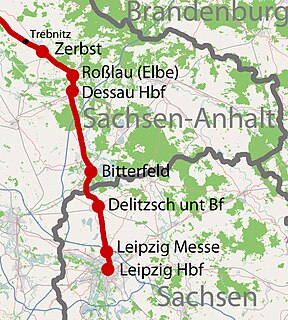
The Trebnitz–Leipzig railway is a double track electrified main line in the German states of Saxony-Anhalt and Saxony built and originally operated by the Berlin-Anhalt Railway Company. It formally starts at Trebnitz on the former border between the Duchy of Anhalt and Prussia and runs via Dessau and Delitzsch to Leipzig. The section from Bitterfeld to Leipzig is part of Line 1 of the Trans-European Transport Networks (TEN-T). Until 1871, the Zerbst–Roßlau section was called the Anhaltische Leopoldsbahn.

Oebisfelde is a railway station located in Oebisfelde, Germany. The station opened in 1871 and is located on the Berlin-Lehrte Railway. The train services are operated by Deutsche Bahn.

Rathenow is a railway station on the Berlin–Lehrte railway located in Rathenow, in the Havelland, Germany. It is used by about 3,300 passengers daily.

The Hagenow–Schwerin railway is a double track electrified mainline railway in the German state of Mecklenburg-Vorpommern. It is the second oldest railway in Mecklenburg after the Berlin-Hamburg railway and one of the oldest railways in Germany, opened in 1847 by the Mecklenburg Railway Company.
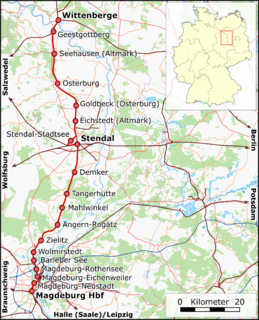
The Magdeburg-Wittenberge railway is a two-track, electrified main line in the east of the German state of Saxony-Anhalt. It is one of the oldest lines in Germany, opened in 1849 by the Magdeburg-Wittenberge Railway Company, which operated it until 1863, when it was taken over by the Magdeburg-Halberstadt Railway Company. It was nationalised in 1879.

The Wilhelmshaven–Oldenburg railway is a predominantly double-track, non-electrified main line in the northwest in the German state of Lower Saxony. It runs to the south from the port city of Wilhelmshaven to Oldenburg. The line is being upgraded in connection with the construction of JadeWeserPort so that it will be continuously duplicated and electrified.

The Lübeck–Bad Kleinen railway is a single-track, non-electrified main line between the German states of Schleswig-Holstein and Mecklenburg-Vorpommern. Its construction was started by the Lübeck-Kleinen Railway Company and, after that company’s bankruptcy, it was completed and opened by the Friedrich-Franz Railway (Friedrich-Franz-Eisenbahn).

Riesa station is the only passenger station of the town of Riesa in the German state of Saxony. It is a regular stop for Intercity and Intercity-Express services. The station is located at kilometer 65.8 of the Leipzig–Dresden railway. In addition, it is at the beginning of the Riesa–Chemnitz railway and the disused Riesa–Nossen railway. Since December 2013 the station has been part of the S-Bahn Mitteldeutschland network.
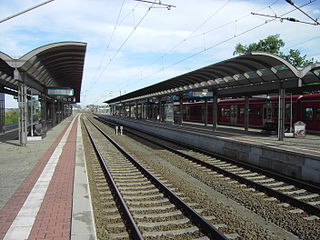
Salzwedel station is the station of the district town of Salzwedel in Altmark in the German state of Saxony-Anhalt. Until 2004, it was a railway junction, but as a result of the closure of nearly all branch lines it has lost most of its importance. Only one railway line still runs through Salzwedel.
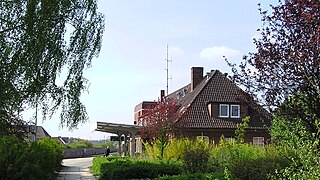
Büchen station is a railway junction in Büchen in the German state of Schleswig-Holstein. About 4,000 passengers embark or disembark each day.






